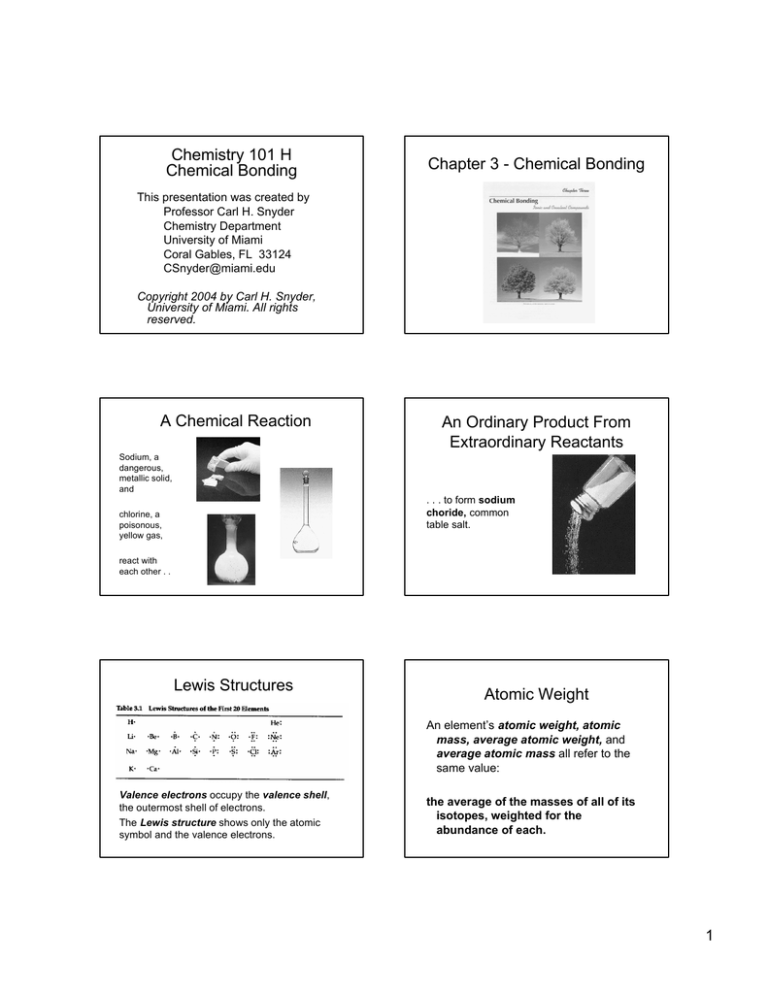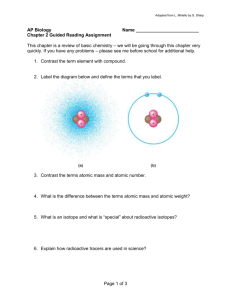Chemistry 101 H Chapter 3 - Chemical Bonding Chemical Bonding
advertisement

Chemistry 101 H Chemical Bonding Chapter 3 - Chemical Bonding This presentation was created by Professor Carl H. Snyder Chemistry Department University of Miami Coral Gables, FL 33124 CSnyder@miami.edu Copyright 2004 by Carl H. Snyder, University of Miami. All rights reserved. A Chemical Reaction An Ordinary Product From Extraordinary Reactants Sodium, a dangerous, metallic solid, and . . . to form sodium choride, common table salt. chlorine, a poisonous, yellow gas, react with each other . . Lewis Structures Atomic Weight An element’s atomic weight, atomic mass, average atomic weight, and average atomic mass all refer to the same value: Valence electrons occupy the valence shell, the outermost shell of electrons. The Lewis structure shows only the atomic symbol and the valence electrons. the average of the masses of all of its isotopes, weighted for the abundance of each. 1 The Periodic Table (A Modern Version) Families and Periods Atomic Number, Atomic Weight The whole number above (in this case) or below the elemental symbol represents the atomic number The fractional number above or below (in this case) the symbol represents the atomic weight or the atomic mass The Alkali Metal Family The alkali metals Except for hydrogen, each is a metal that reacts with water to produce hydrogen gas. Each has a single valence electron. The Alkaline Earth Family The alkaline earth family. Each is a metal. Each has two valence electrons. The Halogen Family The Halogen Family Each member reacts with an alkali metal to form an electrolyte Each member lacks only a single valence electron to form a complete (or temporarily complete) valence shell. 2 The Noble or Inert Gas Family The Noble or Inert Gas Family All of the elements in this family are inert, or nearly inert gases. Each holds a filled (or temporarily filled) valence shell. Na + Cl ---> NaCl Lewis Structures Here, the transfer of an electron from the sodium atom to the chlorine atom is shown through Lewis structures. Ionic Bonds Na + Cl --> NaCl Full Electronic Structures An electron transfers from the valence shell of the sodium atom to the valence shell of the chlorine atom, creating a sodium cation and a chloride anion. The Sodium Chloride Crystal In a crystal of sodium chloride, the sodium cations and chloride anions arrange themselves next to each other, in an orderly, 3-dimensional array. They are held in position by ionic bonds. The Reaction of Calcium and Chlorine An ionic bond results from the mutual attraction of oppositely charged ions. An ionic bond forms as a result of the mutual attraction of a cation (such as a sodium ion) and an anion (such as a chloride ion). One calcium atom, with two valence electrons, reacts with two chlorine atoms, each of which requires only one electron to complete its octet. The product consists of one calcium cation and two choride anions, CaCl2, calcium chloride. 3 A Covalent Bond The Covalent Bond -- H2 A covalent bond forms as two atoms share a pair of electrons. A shared pair of electrons characterizes a covalent bond. The Covalent Bond -- F2 Diatomic Molecules with Single Bonds Hydrogen H-H H2 The Halogens F-F F2 Cl-Cl Cl2 Br-Br Br2 I-I I2 Oxygen - A Diatomic Molecule with a Double Bond Nitrogen - A Diatomic Molecule With A Triple Bond 4 Water, A Covalent Compound A water molecule, H2O, forms as two H atoms share their valence electrons with an O atom. Ionization Ionization occurs when a covalent bond ruptures to form a cation and an anion. Water ionizes when a proton (a hydrogen nucleus) moves away from the pair of electrons it shares with another atom. The Reversible Ionization of Water Reversible ionization takes place when both ionization and the recombination of the ions occur concurrently throughout the substance. It’s indicated by two arrows, with reversed directions. End - Chapter 3 5





